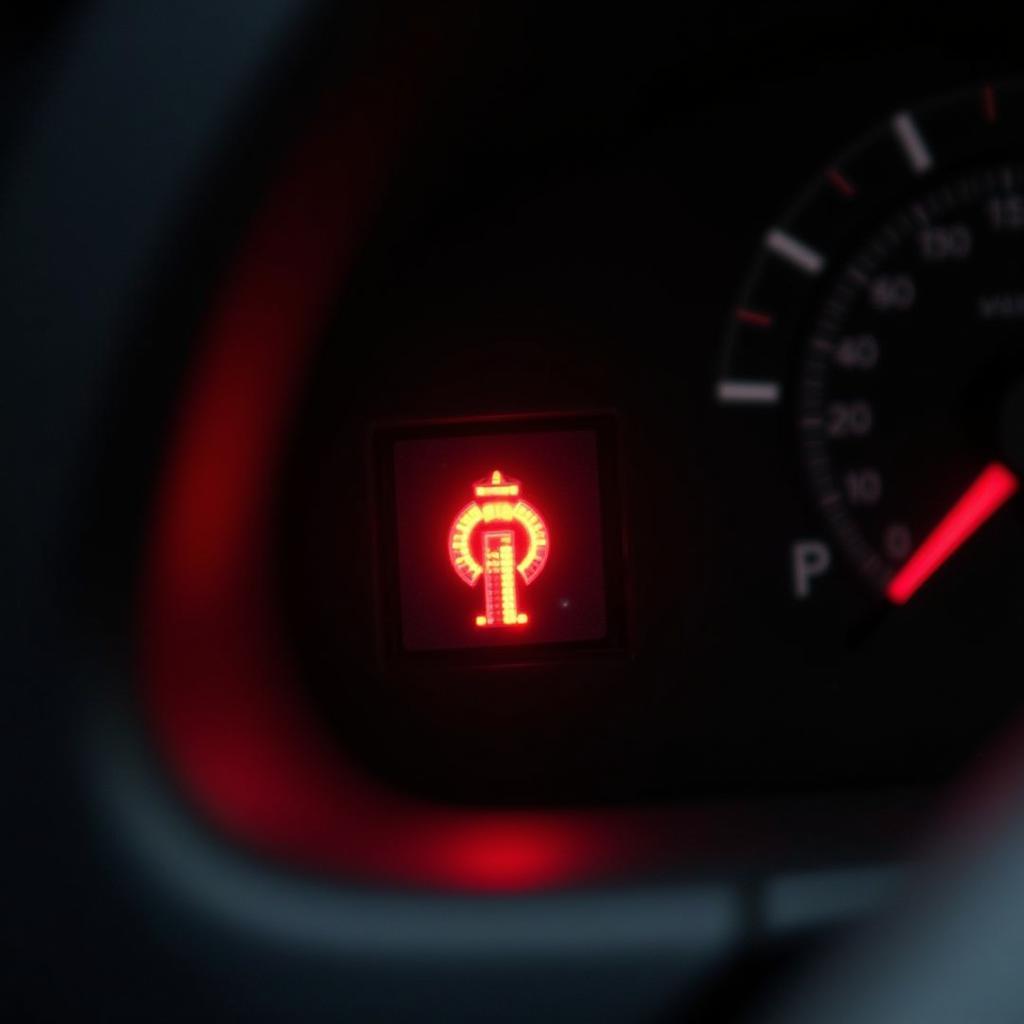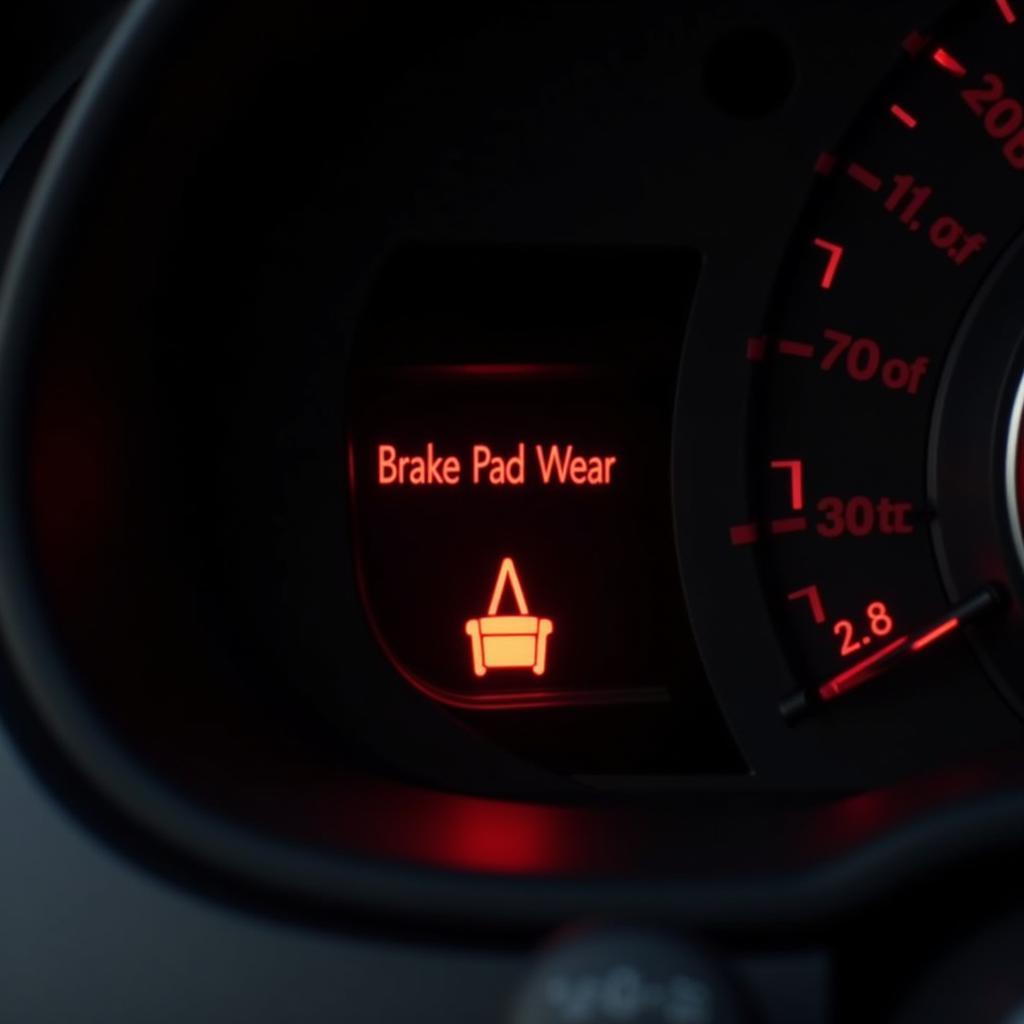The brake warning light on your dashboard is a crucial safety indicator. Understanding what “brake warning light on” means can be the difference between a minor inconvenience and a major car repair. This article dives deep into the brake warning light, its various meanings, and what you should do when it illuminates.  Brake Warning Light Illuminated on Car Dashboard
Brake Warning Light Illuminated on Car Dashboard
Understanding the Brake Warning Light
The brake warning light, typically a red or orange symbol resembling an exclamation point within a circle or parentheses, signals a potential problem with your braking system. Ignoring this warning can lead to dangerous driving conditions and costly repairs. While a simple parking brake engagement can trigger the light, other more serious issues can also be the culprit.
What “Brake Warning Light On” Definition Really Means
The “brake warning light on” definition encompasses several possibilities, ranging from simple to complex. It essentially means your car’s onboard computer has detected an issue within the braking system. This could be anything from low brake fluid to a malfunctioning ABS system. Don’t panic, but don’t ignore it either.
What are the most common reasons for the brake warning light? Low brake fluid is a frequent cause. Worn brake pads can also trigger the light. In some vehicles, a faulty sensor in the braking system can activate the light even if there’s no actual problem.
Common Causes of an Illuminated Brake Warning Light
Several factors can cause your brake warning light to come on. Let’s explore some of the most common culprits:
- Low Brake Fluid: This is the most common reason. A leak in the brake lines can deplete fluid levels, compromising braking performance.
- Worn Brake Pads: Thin brake pads trigger a sensor that activates the warning light, signaling the need for replacement.
- Faulty ABS System: Issues with the Anti-lock Braking System (ABS) can trigger the light. This could be due to a sensor malfunction or other ABS component failure.
- Parking Brake Engaged: Sometimes, the simplest explanation is the correct one. Make sure the parking brake is fully disengaged.
- Brake Light Issues: A burned-out brake light can sometimes trigger the warning light in certain car models.
Troubleshooting the Brake Warning Light
When the brake warning light illuminates, it’s crucial to take action. Here’s a step-by-step guide on how to troubleshoot the issue:
- Check the Parking Brake: Ensure the parking brake is fully released.
- Inspect Brake Fluid Level: Locate the brake fluid reservoir under the hood and check the fluid level. If it’s low, add the correct type of brake fluid.
- Examine Brake Pads: Visually inspect your brake pads through the wheel spokes. If they appear thin, consult a mechanic for replacement.
- Check Brake Lights: Verify all your brake lights are functioning correctly. Replace any burned-out bulbs.
program chrysler proximity key fob
“Regular brake system inspections are crucial for maintaining safety and preventing costly repairs. Don’t wait for the warning light to illuminate before addressing potential problems.” – Johnathan Davis, Automotive Diagnostics Specialist
Advanced Diagnostics and Remote Solutions
If the basic troubleshooting steps don’t resolve the issue, more advanced diagnostics are necessary. This often involves using specialized diagnostic tools to pinpoint the problem.
Remote Diagnostics and Programming
Remote diagnostics and programming offer a convenient and efficient way to address certain brake system issues. Through specialized software, technicians can access your vehicle’s computer remotely to identify and sometimes even fix the problem without physical access to the car.
“Remote diagnostics are revolutionizing the automotive repair industry, offering faster and more efficient solutions to complex vehicle problems.” – Maria Sanchez, Automotive Software Engineer
When to Seek Professional Help
While some brake warning light issues can be resolved with simple DIY solutions, others require professional expertise. If you’ve checked the basics and the light persists, consult a qualified mechanic immediately. Ignoring a persistent brake warning light can compromise your safety and lead to more serious and expensive repairs down the line.
Conclusion
The “brake warning light on” definition signifies a potential issue within your braking system. While it could be something as simple as a disengaged parking brake, it could also indicate more serious problems. Understanding the various causes and taking appropriate action can ensure your safety and prevent costly repairs. Regular brake system maintenance and prompt attention to warning signs are essential for safe and reliable vehicle operation.


